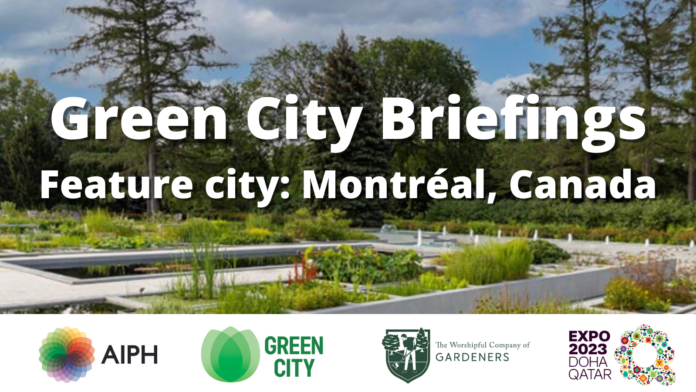Tim Badman, Head of the Heritage, Culture and Youth Team in the International Union for Conservation of Nature (IUCN), introduced the fifth session in the series. This briefing featured Montréal, Canada, winner of the ‘Living Green for Water’ category of the inaugural AIPH World Green City Awards. The city received the award for the Phytotechnology Stations at the Montréal Botanical Garden. These stations have the dual goals of addressing environmental issues on the site and demonstrating the use of the technology.
Joan Laur, Scientific Director of the Pathway to Phytotechnology for the Research and Development Division of the Montréal Botanical Garden, explained: “We wanted to showcase how plants can be used to address environmental problems.”
“This is a historic Botanical Garden, but we are moving towards something more resilient. In our first Phytotechnology Station, we implemented two filtering marshes on the edge of the existing aquatic garden.” The marshes filter the water used in the garden to ensure it is of good quality (i.e. by removing phosphorus and nitrate surpluses and removing suspended solids). Joan added: “The water is in a closed loop so we are not wasting anything. It was a huge success and showcased how beautiful green infrastructure can be.”
The Montréal Botanical Garden has installed two further Phytotechnology Stations to address different issues. Find out more in the case study on the AIPH website.
Expanding on the use of plants in city water management, Gary Grant, Technical Director at the Green Infrastructure Consultancy, highlighted the benefits of green walls. In particular, he emphasised the use of plants to keep buildings cool.
“Ornamental features or features that provide biodiversity can also save water and you get the evaporative cooling in summer as well. We’re all concerned about climate change and heatwaves.” Gary presented a thermal image of buildings in Southhampton Row, London, which shows a very hot day. A conventional building’s wall reached 40 °C, but the green wall maintained a temperature of 28.4°C due to evaporative cooling.
However, green walls are not without their challenges. Gary explained that one of the criticisms of green walls is that they waste water. Innovative solutions have been used to prevent water wastage by utilising rainwater. Gary said: “We divert downwater from drains into tanks that sit behind a green wall. That water is then fed into the planters. Although this was an experiment, it’s worked incredibly well.” Gary went on to say that there is a problem with out-of-date attitudes to the maintenance of green infrastructure, and this needs to be promoted as a skilled and essential profession.
Watch this briefing on-demand.
Organised by the International Association of Horticultural Producers (AIPH) in collaboration with the Worshipful Company of Gardeners (WCoG) and sponsor Expo 2023 Doha Qatar, the AIPH Green City Briefings 2022/23 are a series of one-hour webinars focussing on cities around the world that demonstrate significant progress in including plants and nature in their city’s form and function.
The next AIPH Green City Briefing will focus on the winner of the ‘Living Green for Social Cohesion’ category of the AIPH World Green City Awards 2022: Paris, France. The award was given for the ‘OASIS Schoolyard Project’, which sought to renew existing public schoolyards. By December 2021, 72 schoolyards had been transformed into green spaces for children to enjoy.
The briefing will take place on 21st March 2023 at 1pm GMT. For more information and to register, visit the AIPH Website.




